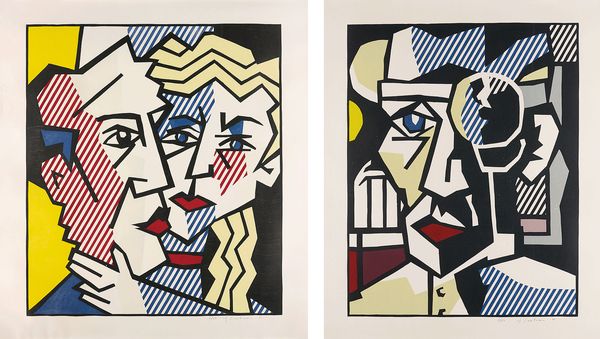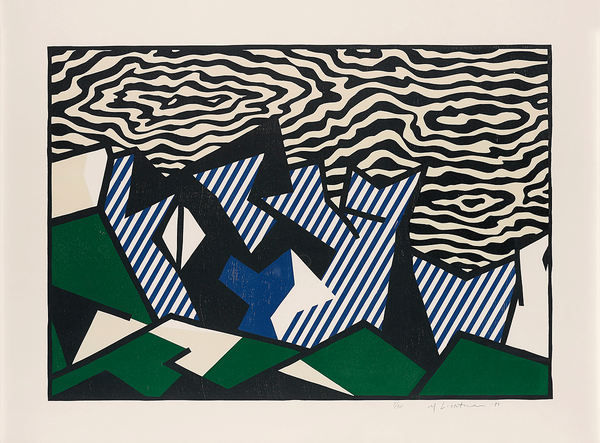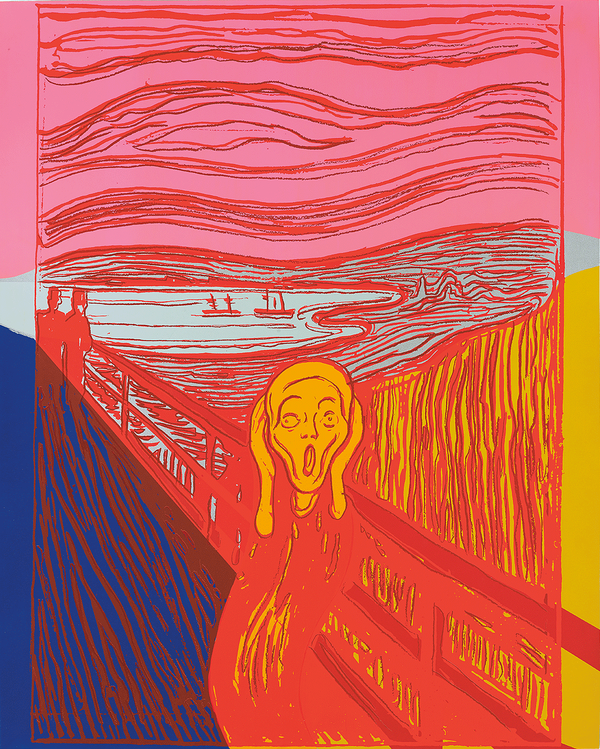The visual legacies of Roy Lichtenstein and Andy Warhol are unequivocally enmeshed with the tenets of Pop Art, sharing a liberal appropriation of the aesthetics of American popular culture, and an insistent concern with the superficial wonder of permanent commodification. The iconic styles of these two artists (the Ben-Day revisions and flat colour fields) are the manifestation of an attempt to create an affectless, deadpan, authorless style that nonetheless betrays the immediately recognisable branding of their makers.
Yet despite their focus on contemporary, everyday imagery (including advertisements, comics, celebrities, and soup-cans) both Lichtenstein and Warhol repeatedly turned their attention to art history. From the late 1960s, Lichtenstein began exploring classical motifs, with the defining elements of Futurism, Cubism, Surrealism, and finally Expressionism featuring regularly in his work throughout the following decades. Similarly, in the 1980s, Warhol transformed singular historical works of art (or rather, their reproductions) into recognisably Warholian icons, with his versions of works by Lucas Cranach, Giorgio de Chirico, and Edvard Munch, along with his Details of Renaissance Paintings series, forming the backbone of Warhol’s last, busy decade.
The interest that both Lichtenstein and Warhol were paying to art history and in particular to selecting and then mimicking past visual tropes and motifs, is evident in both artists’ interpretation of Claude Monet’s painted series of Rouen Cathedral (1892-1895). Lichtenstein simplified and, in a sense, effaced the essence of Monet’s paintings in his 1969 Rouen Cathedral V series, flattening the complex layers of heavily impastoed colours into forms that simulated Ben-Day dots. Whereas Warhol took Cologne cathedral in 1985 as the subject for a set of four screenprints, with the architectural motif printed deliberately out-of-register on a flat colour background, creating vibrant and indeed almost vibrating versions of Monet’s shimmering pastel views. For both Lichtenstein and Warhol, the subject of the cathedral (either Rouen or Cologne) is less important than delving into the nature of repetition and seriality. Both artists appropriated an iconic image, one of the hallmarks of the Impressionist revolution - familiar to the viewer and artist through commercial overexposure, and re-invested it with an ironic vigour and visual relevance.
It is this concern with repetition and seriality, of continuing (through parody) a series of familiar images that is key to both artists’ exploration of art history, and which strikes the clearest irony in their borrowing of Expressionist motifs.
Everything I do is a comment on something. It’s ironic or humorous. When I do a still life, it’s a comment on the act of doing a still life painting it’s meant to make the spectator wonder about it.
– Roy Lichtenstein
Lichtenstein and Warhol began to parody Expressionism and its most recognisable works within a few years of each other. During a trip to Los Angeles in 1978, Lichtenstein became fascinated by lawyer Robert Gore Rifkind’s collection of German Expressionist prints and illustrated books, and in 1980 began exploring the Expressionist stylistic vocabulary in paintings such as The White Tree, which evokes the lyricism of Der Blaue Reiter landscapes, and Expressionist Head that mimics Erich Heckel’s 1919 woodcut, Portrait of a Man.
Lichtenstein also created a number of small pencil drawings that he used as templates for woodcuts, a medium favoured by Emile Nolde and Max Pechstein among other Expressionist artists. The culmination of this exploration was the Expressionist Woodcut Series, 1980. This set of seven woodcuts includes motifs that echo the Expressionist masterpieces, such as Dr. Waldmann, which recalls Otto Dix’s Dr. Mayer-Hermann, 1926, and Reclining Nude: an addition to Lichtenstein’s repertoire of iconography that had hitherto excluded nude figures.
(Left) Roy Lichtenstein The Couple, from Expressionist Woodcut Series, 1980. (Right) Roy Lichtenstein Dr. Waldman, from Expressionist Woodcut Series, 1980.
In his woodcut series, rather than simply copying the figures and compositions of the artworks that he was inspired by in Rifkind’s collection of prints, Lichtenstein mimics instead the techniques and materials used by the Expressionist artists. In abandoning his typical Ben-Day dots in favour of tight diagonal lines and exaggerated woodgrain patterns, both flatly applied with unmodulated colour, Lichtenstein draws attention to the surface of the work. He thereby reduces the importance of the subject and its narrative, plucking at the stylistic strings of Expressionism whilst leaving the raw emotional tone of the movement behind.
To create the Expressionist Woodcut Series, Lichtenstein chose a Baltic birch, due to its hardness, but then deliberately cut across the grain to minimise the printed texture and instead create a smooth surface with even colouration. In 1982 to Deborah Phillips, Lichtenstein explained, “I want a mechanical image in my prints. But after a while, I was able to achieve that technical quality too easily. Woodcuts resist that. I like the way you have to fight against the block to get the image you want it’s a real feat to see if you can make a woodcut without getting a woodcut quality.”
Lichtenstein strove to deny the surface of his prints the ‘woodcut quality’ inherent to the material, but then subsequently included an oversized, exaggerated woodgrain pattern in the design, particularly in the background of Morton A. Mort. By alluding to, but simultaneously denying the nature of the woodcut medium, Lichtenstein upset the focus on truth to material operative within much Modernist work, and pushed beyond the limits of an authentic homage or direct conversation with the original Expressionist artworks. Instead he emphasises the ‘fake-ness’ of his printed surfaces and alludes to the aesthetic of commercial reproduction that was key to the Pop art style.
Roy Lichtenstein Morton A. Mort, from Expressionist Woodcut Series, 1980
Whereas Lichtenstein engaged with the tropes and motifs of Expressionism as a holistic movement, Warhol instead was inspired by the work of a single Expressionist master: Edvard Munch. At first it may seem surprising that Warhol chose to emulate the work of Munch. Nothing about the glib, manufactured surfaces of Warhol’s hotly-coloured paintings and screenprints seems to resonate with the profoundly existentialist and emotionally redolent work of Munch. Indeed, Robert Rosenblum once noted that it would be difficult to find an artist who, on a psychological level, better symbolised a negation of Warhol’s poker-faced emotional anaesthesia than Munch.
And yet, in the autumn of 1982, Galleri Bellman, located on 57th Street, exhibited a spectacular show of 126 paintings and prints by Munch, with a reproduction of Munch’s 1895 lithograph The Scream gracing the title page of the exhibition catalogue. Warhol visited this exhibition multiple times and, in 1983, was approached by a partner in the gallery with a view to commission a series of paintings and screenprints based on four of Munch’s lithographs: The Brooch (Eva Mudocci), Self Portrait, Madonna, and The Scream. It is the latter of these four prints that inspired Warhol to create The Scream (after Munch), 1984.
Despite their apparent artistic differences, Warhol seized the opportunity to work with one of the most instantly recognisable subjects of Munch’s work. By the time Warhol began work on this commission, The Scream had already been the subject of Munch’s own repetition and appropriation as he re-interpreted and amended the motif for new creative ends. As Munch explained in an undated letter to Axel Romadahl, “I have often repeated my pictures – but it is always a progression and never the same. I build one picture on top of another.” With an existing history of re-appropriation, The Scream was no doubt a particularly magnetic motif for Warhol, who saw Munch’s widely deployed and rapaciously commodified imagery as ready-mades, ripe for his own adaptation.
Andy Warhol The Scream (after Munch), 1984
Upon beginning his translation of Munch’s seminal motif, Warhol first ordered photographs of the original lithograph to be blown up so that he could trace the enlarged images of the reproduction. At this stage, Warhol began subtracting passages from Munch’s composition, selecting the elements that would remain as signifiers of the original and simplifying them into elemental graphic forms. What remains in the present lot are signposts – selected notations of the original.
Just as Lichtenstein drew all attention to the surface of his Expressionist Woodcut Series, and thereby distanced his work from the original emotive Expressionist works, so too did Warhol turn attention away from Munch’s narrative of anxiety. Instead, he explores the motif for its many constitutive formal elements, using a juxtaposition of hot and cool colours that jump forward with maximum optical dynamism and dissonance. The disparate lines and shapes of the composition are given emphatic and distinct visibility creating a tangible vibration of colour. Warhol makes clever virtue out of overprinting and overlapping to present a slightly out-of-register image that dances before the viewer’s eye and keeps their attention firmly at the surface of the screenprint.
Lichtenstein and Warhol adopted very different approaches when appropriating the imagery of Expressionism: Lichtenstein considered the principles and aesthetic of the movement as a whole, whilst Warhol concentrated on the work of a single artist. However, in both Lichtenstein's Expressionist Woodcut Series, and Warhol's The Scream (after Munch), the distance between the original and the variation is palpably rendered, oscillating in authorship between Pop and Expressionism. Both artists parody the motifs and stylistic language of Expressionism through repetition of form without narrative, and thereby create iconic Pop Art images: all surface, colour and irony.



